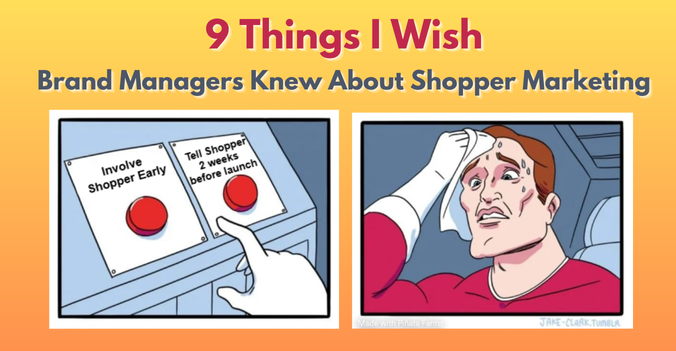.png?width=487&name=Guided%20Decentralization%20of%20Shopper%20Marketing%20(1).png) The U.S. Army War College introduced the concept of VUCA to describe the more volatile, uncertain, complex and ambiguous multilateral world perceived as resulting from the end of the Cold War.
The U.S. Army War College introduced the concept of VUCA to describe the more volatile, uncertain, complex and ambiguous multilateral world perceived as resulting from the end of the Cold War.
Similarly, today’s world of CPG and Retail feels a lot like the end of an old era and has all the characteristics of a VUCA environment.
Shopper marketing was born in that old era a couple of decades ago. Today, our decades-old approaches and management techniques do not work anymore. How do shopper marketing leaders adjust their management style to these new realities and foster productive tension within their teams and across the matrix?
I recently attended MarTech Conference where I witnessed an amazing keynote presentation by Kathleen Schaub, Vice President, CMO Advisory Services at IDC. Her presentation was centered around marketing technology and how it empowers “guided decentralization”. Guided decentralization, she argues, is an essential quality of modern teams who thrive and win in VUCA world. She likens today’s marketers to soldiers on battle fields, surgeons and nurses in operating rooms, and pilots and air traffic controllers.
I believe that guided decentralization is what will make shopper marketing succeed in the next decade, too. Let’s break down the theory of guided decentralization into practical steps that must be be taken to make it come to life.
To enable guided decentralization means to implement decentralization without losing oversight and accountability. Both are required to achieve the positive effect.
.png?width=392&name=Marketing%20Budget%20Is%20The%20Ultimate%20Expression%20Of%20Strategy%20(2).png)
To Decentralize:
1. Push decision making as close to the customer as possible.
Avoid elaborate approval workflows. This is not now Shopper Marketing wins. Let go of control and micro-management. Trust in local, field expertise, they are on the ground, in front of a retail customer, with intimate shopper knowledge at hand, and they know what needs to be done. Instead, offer subject-matter experts’ perspective and support to complement field team’s local expertise. For instance, have a digital media buyer expert in house who can train and consult field teams on how to negotiate with vendors instead of mandating that all media buys are done centrally.
2. Provide budgets up-front.
Don’t breed the culture of “dialing for dollars”. Some of the least empowered people in our industry are shopper marketers who do not own any budgets. These people have no formal authority, and therefore accountability, to make investment decisions. They only “influence” those who have money. Who will you blame if a program did not execute on time due to delays with approvals? In VUCA world, you can’t afford to employ an army of influencers.
3. Be open to new ideas coming from the field.
Listen to customer-facing team’s input when developing strategic plans. Annual Operating Planning is flawed if it doesn’t start with sharing workshops with customer-facing sales and marketing teams where major customers’ strategies are surveyed and discussed.
4. Share information with the field instantaneously.
Do not wait till next monthly call to update the team about new org changes, upcoming new product introductions or latest shopper research findings. It will be obsolete by then, and momentum will be lost. Don’t want to share national Consumer Promotions plans until they are “fully baked”? Trust that these plans will only become stronger if customer-facing teams help put finishing touches on them.
To Maintain Oversight And Accountability:
5. Create a shared mission.
Clearly articulate what shopper marketing is charged with and what key strategic priorities they should go after. Avoid too many “priorities”, or a laundry list of “to dos”. Go for scale and impact by focusing on fewer, bigger, better initiatives.
6. Develop “Spending principles”
It can be a simple, one page document that guides proper marketing investments. This is an invaluable resource that your teams can use to make quick decisions, defend those decisions, as well as avoid ambiguity and navigate gray areas that are so abundant in shopper marketing. Read about spending principles in our recent post.
7. Standardize planning and reporting.
Old school methods of managing your marketing operations in Excel are no longer cutting it. Deploy automated planning systems like Shopperations across your entire team to ensure everyone operates with the same level of granularity and attention to detail.
8. Embrace radical transparency.
Automation solutions must not only standardize planning and reporting, but also offer real time visibility to what’s happening in the field. Customer-facing teams should know that while their plans will not be put through elaborate approvals, everything they do is auditable and should comply with the spending principles.
9. Enable agile action and frequent feedback loops.
Instead of up-front approvals that slow everyone down, establish a requirement to set program objectives and KPI goals up-front to avoid “spin” after the fact. Create retrospective rituals to help teams reflect on performance of programs and inform future action.
Are you looking for help with empowering your shopper marketing teams to take ownership and drive action? Let’s connect! We can show how Shopperations helps CPG clients create a decentralized, empowered Shopper Marketing organizations, without losing oversight and accountability.





.png)



